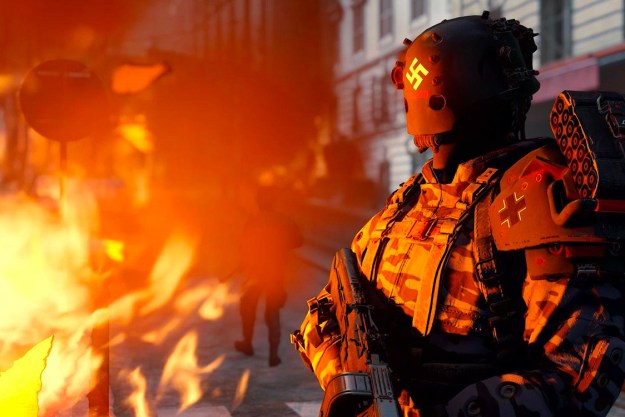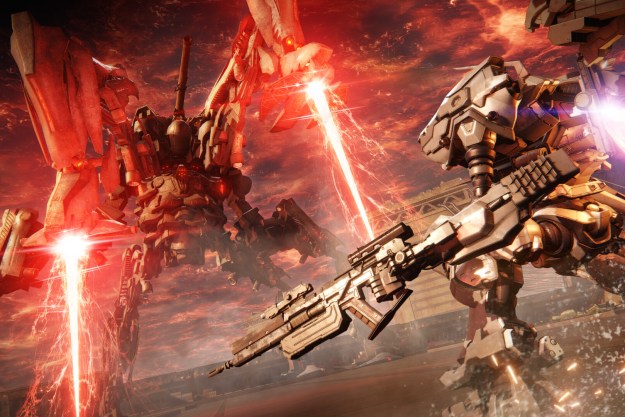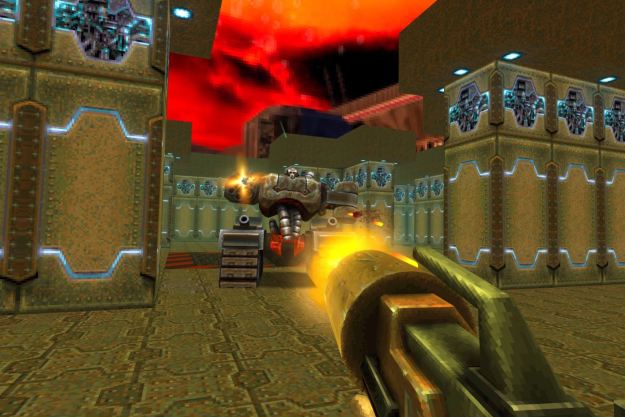
- Loveable main characters
- Fun co-op
- Unlockable skills compliment gameplay
- Open format allows you to play at your own pace
- Pep Signals are great tools in combat
- Weapon modifications don't feel substantial
- AI is finicky
- Final boss is a bullet sponge
From its goofy sisters and cooperative play to its RPG-style progression and non-linear missions, Wolfenstein: Youngblood takes the series down a new path. Its co-op holds weight, skill upgrades feel substantial, and it doesn’t hold your hand when you’re deciding which missions to complete. Like its teenage protagonists, though, this Wolfenstein spinoff is not without a few blemishes.
A family affair
Youngblood sets aside the super-serious tone of its predecessors with the humorous Blazkowicz twins — Jess and Soph. As you might expect from the children of franchise heroes Ana and BJ Blazkowicz, the twins are Nazi-killing machines.
Well, for the most part. Soph gets sick after her first Nazi kill, but that’s followed up by a hearty laugh as her sister Jess gags on a piece of brain she finds in her mouth. They overcome their squeamishness quickly though, and their cheesy banter keeps spirits high during combat.
Before jumping into combat, you choose the melee weapon, first skill, gun, “Pep Signal,” and armor of each sister. Pep Signals — a new addition to the series — are emotes each sister can use to buff the other. These range from metal horns and a thumbs up to martial arts, and can do things like restore armor and health, revive your sister from afar, make you invulnerable, and more.

Once you’ve selected your initial loadout, Youngblood wastes no time dropping you and your sister into the fight. You can play with a stranger or friend or make use of the game’s AI. The substitute robot sister isn’t terrible as far as AI in games go. It managed to keep up with me in combat and followed my lead when attacking enemies or sneaking past foes. It was slow to help me with any task that required both sisters to work together, and often, when I was struck down by a group of enemies, my AI-controlled sister would continue to shoot at enemies until she was also bleeding out on the battlefield.
Playing co-op with an actual human is more fun, and doubly so if you have a partner that’s willing to work with you. Your progress is largely dependent on both sisters being present and working together, and when you find a rhythm that works, firefights can be downright explosive.
My AI-controlled teammate was slow to help me with any task that required both sisters to work together.
In a boss fight close to the end of the campaign, my sister and I stealthily entered a large area riddled with enemies and patrolled by a massive mech. Our plan to sneak in undetected fell through, and we ended up becoming the targets of an entire room full of Nazis.
In a state of panic, we both responded by pulling out our biggest and baddest guns. I opted for the Laserkraftwerk which (as you might’ve guessed) shoots out lasers, and my sister went with the Dieselhammer, a launcher that shoots out sticky explosives and detonates them.
We were soon melting enemies away, spamming Pep Signals to boost our health, and evading the flame-throwing attacks of the mech. When it was finally defeated and the wave of enemies dissipated, we paused for a moment in the empty space to take a breather and admire our work.
Harder, better, faster, stronger
Combat and co-op go deep as you progress through Wolfenstein: Youngblood. The twins level up independently of one another and acquire ability points that can be used to unlock new skills. Skills fall under the categories Mind, Power, and Muscle, and each skill you unlock can be upgraded to make them more powerful. This adds another meaningful (and necessary) layer to combat. Determined players may be able to get by on bullets alone, but skills are really what prepare you for the end game.
The Cloak skill is great, and you can get fairly early in the game. It grants the power of invisibility for a limited time, and with each upgrade you unlock, increases in duration. This was my go-to whenever I encountered a large room filled with Nazi baddies, since I could scope out the best approach to taking them all down without worrying about being seen. It was great when taking down Kommandants, or Commanders, which call in higher-level backup if you don’t kill them before causing too much of a ruckus.
Using Cloak to dispatch enemies with axes became my signature move, and I only became more lethal as I upgraded that skill. There came a point when I could kill a small room of Nazis without being noticed once, and it felt awesome.
Weapon upgrades in Youngblood aren’t as exciting, unfortunately. There are weapons aplenty and each one you pick up has five modification slots. These include the receiver, sight, muzzle, magazine, and stock. Each modification offers options that target stats such as accuracy, fire rate, and damage.
You’re basically forced to rely on some of the heavy weapons to put a substantial dent in a high-level enemy’s health bar.
When you’re first starting out, these weapon modifications feel important. You’ll learn which weapons can penetrate through the different types of enemy armor and soon enough you’ll feel like Rambo. The Sturmgewehr was the first gun I modified to deal an absurd amount of damage, and I was amazed by how it could take down groups of enemies with a single shot. That didn’t last long.
By unlocking a specific set of skills, you can pick up heavy weapons dropped by some of the tougher enemies. When the enemy difficulty begins to ramp up, these weapons are a blessing. They are quick to run out of ammo, however, so you’ll need to be a bit more strategic when you reach the later stages of the game. No, you cannot zap every enemy into smithereens. Enemies level up alongside you which means they continue to become stronger and more durable. This is when you begin to realize that earlier gun modifications and guns don’t do much in the way of damage. You’re basically forced to rely on some of the heavy weapons to put a substantial dent in a high-level enemy’s health bar.
This makes for some intense boss battles that can be incredibly challenging but it ultimately feels pretty rewarding once you’ve beat them. The final battle in Wolfenstein: Youngblood, however, doesn’t stir those same feelings. The enemy you’re pitted against is a massive bullet sponge, and no amount of unlockable skills, heavy weapons, and Pep Signals can prepare you for that battle. You’re even given an item that upgrades your power suit and unlocks a powerful skill just prior to the fight, but even that’s useless. The feeling after the last battle was more relief than satisfaction.
Young, wild, and Nazi free
Once you complete the first few missions of Wolfenstein: Youngblood, you’ll be sent to the Catacombs in Paris where you can pick and choose which missions you want to do in whatever order you want to do them. This is a great option if you’re not looking for a drawn-out campaign filled with non-essential missions. There are recommended levels for missions that you should adhere to unless you want to be destroyed by higher-level enemies.
Youngblood doesn’t overstay its welcome.
It’s a fair ask for a game that is short in length. I was able to complete the main campaign in about 20 to 25 hours, and that’s after skipping a few less important missions. You can complete the game quickly once you reach level 20, as you can tackle the late-game missions at that point.
The main missions have a predictable format which tasks you with infiltrating a base, making your way through its elaborate infrastructure, breaking into the main control room, fighting a giant mech Nazi, and taking down a few Kommandants. Since Youngblood doesn’t overstay its welcome and regularly introduces new enemies and obstacles, it doesn’t feel all that repetitive.
Our Take
When all is said and done, and Nazi Germany’s ego has been bruised by a couple of rad teenage girls, one fact remains — Wolfenstein: Youngblood is fun as hell. The goofy Blazkowicz sisters make it compelling enough to endure its sometimes annoying quirks. Bring a partner for best results. The game shines when you’re playing co-op alongside a friend.
Microtransactions:
Wolfenstein: Youngblood does include microtransactions that can be used to purchase weapon skins in the game. The microtransactions don’t impact the game’s difficulty. You can also purchase weapon skins using the currency found in the game.
Is there a better alternative?
There are plenty of great first-person shooter co-op games — Far Cry New Dawn, Killing Floor 2, Borderlands 2, and Destiny 2 being some notable examples — but none have the same aesthetic or offer the same experience as Wolfenstein: Youngblood.
How long will it last?
Wolfenstein: Youngblood’s main campaign can be finished in 20 to 25 hours, but if you were to complete all additional missions, max out weapon modifications and character skills, and toy around with the harder difficulties, it could last longer.
Should you buy it?
Yes. If you’re looking for a fun co-op game that encourages teamwork and lets you toy around with your character’s loadout, then you should pick up Wolfenstein: Youngblood.
Editors' Recommendations
- Homeworld 3: release date window, trailer, pre-order, and more
- Here’s when can you expect our Suicide Squad: Kill the Justice League review
- Nvidia DLSS support for Starfield teased alongside stability-improving update
- What is the max level in Starfield?
- All Starfield cheats and console commands







